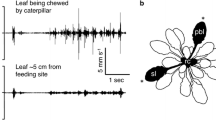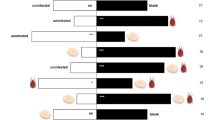Abstract
Feeding by herbivorous insects may change photosynthetic activity of host plants. We studied how feeding and oviposition by herbivorous stink bugs, Murgantia histrionica and Nezara viridula (Heteroptera: Pentatomidae), affect photosynthetic parameters of Brassica oleracea (savoy cabbage) and Phaseolus vulgaris (French bean). First, we measured photosynthetic gas exchange, chlorophyll fluorescence imaging, and emission of induced volatile organic compounds (VOC) immediately after feeding and during a post-feeding period. Photosynthesis decreased rapidly and substantially in B. oleracea and P. vulgaris infested by feeding bugs. Stomatal conductance did not decrease proportionally with photosynthesis; instead, inhibition of photosynthesis likely was due to a reduced diffusion of CO2 in the mesophyll. We also measured the impact of oviposition per se and oviposition associated with feeding on photosynthetic parameters. A surprisingly large inhibition of photosynthesis was detected in cabbage leaves in response to oviposition by M. histrionica, even when oviposition was not associated with feeding activity. High resolution chlorophyll fluorescence imaging revealed that the damage to photochemistry caused by feeding and oviposition was restricted to the attacked areas. By contrast, the photochemical yield increased temporarily in the unaffected areas of the attacked leaves, indicating the onset of a compensatory response. Measurement of volatile organic compounds (VOC) revealed that feeding-damaged plants did not emit detectable amounts of VOC, indicating cellular damage (methanol and green leaf volatiles). However, feeding by M. histrionica induced emission of mono- and sesquiterpenes in savoy cabbage leaves. The different time-course of the induction of these two classes of terpenes may reflect the induction of two different biosynthetic pathways and indicate different roles of these terpenoids in tritrophic interactions.









Similar content being viewed by others
References
Aldea, M., Hamilton, J. G., Resti, J. P., Zangerl, A. R., Berenbaum, M. R., Frank, T. D., and Delucia, E. H. 2006. Comparison of photosynthetic damage from arthropod herbivory and pathogen infection in understory hardwood samplings. Oecologia 149:221–232.
Baker, N. R., Oxborough, K., Lawson, T., and Morison, J. I. L. 2001. High resolution imaging of photosynthetic activities of tissues, cells and chloroplasts in leaves. J. Exp. Bot. 52:615–621.
Bilger, W. and Bjorkman, O. 1991. Temperature dependence of violaxanthin deepoxidation and non-photochemical fluorescence quenching in intact leaves of Gossypium-hirsutum L. and Malvaparviflora L. Planta 184:226–234.
Bin, F., Vinson, S. B., Strand, M. R., Colazza, S., and Jones, W. A. 1993. Source of an egg kairomone for Trissolcus basalis, a parasitoid of Nezara viridula. Physiol. Entomol. 18:7–15.
Bjorkman, O. and Demmig, B. 1987. Photon yield of O2 evolution and chlorophyll fluorescence characteristics at 77 K among vascular plants of diverse origins. Planta 170:489–504.
Browse, J. and Howe, G. A. 2008. New weapons and a rapid response against insect attack. Plant Physiol. 146:832–838.
Burd, J. D. and Elliott, N. C. 1996. Changes in chlorophyll a fluorescence induction kinetics in cereals infested with Russian wheat aphid (Homoptera: Aphididae). J. Econ. Entomol. 89:1332–1337.
Chaerle, L., Hagenbeek, D., De bruyne, E., and Van der straeten, D. 2007. Chlorophyll fluorescence imaging for disease-resistance screening of sugar beet. Plant Cell Tiss. Org. 91:97–106.
Colazza, S., Mcelfresh, J.S., and Millar, J.G. 2004a. Identification of volatiles synomones, induced by Nezara viridula feeding and oviposition on bean spp., that attract the egg parasitoid Trissolcus basalis. J. Chem. Ecol. 30:945–963.
Colazza, S., Fucarino, A., Peri, E., Salerno, G., Conti, E., and Bin, F. 2004b. Insect oviposition induces volatiles emission in herbaceous plant that attracts egg parasitoids. J. Exp. Biol. 207:47–53.
Colazza, S., Salerno, G., and Wajnberg, E. 1999. Volatile and contact chemicals released by Nezara viridula (Heteroptera: Pentatomidae) have a kairomonal effect on the egg parasitoid Trissolcus basalis (Hymenoptera: Scelionidae). Biol. Control 16:310–317.
Conti, E., Salerno, G., Bin, F., and Vinson, S. B. 2004. The role of host semiochemicals in parasitoid specificity: a case study with Trissolcus brochymenae and Trissolcus simoni on pentatomid bugs. Biol. Control 29:435–444.
Conti, E., Salerno, G., De santis, F., Leombruni, B., and Bin, F. 2006. Difese indirette delle piante: i sinomoni per contatto indotti da ovideposizione. Atti Accademia Nazionale Italiana di Entomologia. Rendiconti Anno LIV: 129–148.
Conti, E., Zadra, C., Salerno, G., Leombruni, B., Volpe, D., Frati, F., Marucchini, C., and Bin, F. 2008. Changes in the volatile profile of Brassica oleracea due to feeding and oviposition by Murgantia histrionica. Eur. J. Entomol. 105:839–847.
Di marco, G., Manes, F. S., Tricoli, D., and Vitale, E. 1990. Fluorescence parameters measured concurrently with net photosynthesis to investigate chloroplastic CO2 concentration in leaves of Quercus ilex L. J. Plant Physiol. 136:538–543.
Dicke, M. and Hilker, M. 2003. Induced plant defences: From molecular biology to evolutionary ecology. Basic Appl. Ecol. 4:3–14.
Dicke, M. and Baldwin, T. 2010. The evolutionary context for herbivore-induced plant volatiles: beyond the “cry for help”. Trends in Plant Sci. 15:167–175.
Dicke, M., Van loon, J. J. A., and Soler, R. 2009. Chemical complexity of volatiles from plants induced by multiple attack. Nature Chem. Biol. 5:317–324.
Evans, J. R. and Loreto, F. 2000. Acquisition and diffusion of CO2 in higher plant leaves, pp. 321–351, in R. C. Leegood, T. D. Sharkey, S. von Cammerrer (eds.). Photosynthesis: Physiology and Metabolism, Kluwer Academic, The Netherlands.
Genty, B. and Harbinson, J. 1996. Regulation of light utilization for photosynthetic electron transport, pp. 69–99, in N. R. Baker (ed.) Photosynthesis and the Environment. Kluwer Academic, Dordrecht.
Genty, B., Briantais J. M., and Baker, N. R. 1989. The relationship between the quantum yield of photosynthetic electron transport and quenching of chlorophyll fluorescence. Biochim. Biophys. Acta 990:87–92.
Glazebrook, J. 2005. Contrasting mechanisms of defense against biotrophic and necrotrophic pathogens. Annu. Rev. Phytopathol. 43:205–227.
Gomez, S. K., Oosterhuis, D. M., Hendrix, D. L., Johnson, D. R., and Steinkraus, D. C. 2006. Diurnal pattern of aphid feeding and its effect on cotton leaf physiology. Environ. Exp. Bot. 55:77–86.
Guerrieri, E. and Digilio, M. C. 2008. Belowground mycorrhizal endosymbiosis and aboveground insects: Can multilevel interactions be exploited for a sustainable control of pests? pp. 125–152 in C. S. Nautiyal and P. Dion (eds.). Molecular Mechanisms of Plant and Microbe Coexistence. Soil Biology 15. Springer-Verlag Berlin Heidelberg.
Haile, F. J., Higley, L. G., Ni, X., and Quisenberry, S. S. 1999. Physiological and growth tolerance in wheat to Russian wheat aphid (Homoptera: Aphididae) injury. Environ. Entomol. 28:787–794.
Hare, J. D. and Elle, E. 2002. Variable impact of diverse insect herbivores on dimorphic Datura wrightii. Ecology 83:2711–2720.
Hatanaka, A. 1993. The biogeneration of green odour by green leaves. Phytochemistry 34:1201–1218.
Hilker, M., Rohfritsch, O., and Meiners, T. 2002. The plant’s response towards insect egg deposition. pp. 203–228 in M. Hilker and T. Meiners (eds.). Chemoecology of Insect Eggs and Egg Deposition.
Hilker, M. and Meiners, T. 2006. Early herbivore alert: Insect eggs induce plant defense. J. Chem. Ecol. 32:1379–1397.
Hory, K. 2000. Possible causes of disease symptoms resulting from the feeding of phytophagous Heteroptera. pp 11–35 in C. W. Schaefer and A. R. Panizzi (eds.). Heteroptera of Economic Importance.
Karban, R. and Baldwin, I. T. 1997. Induced Responses to Herbivory. The University of Chicago Press, Chicago. p. 301.
Kolb, T. E., Mccormick, L. H., and Shumway, D. L. 1991. Physiological responses of pear thrips-damaged sugar maples to light and water stress. Tree Physiol. 9:401–413.
Loreto, F., Barta, C., Brilli, B., and Nogues, I. 2006. On the induction of volatile organic compound emissions by plants as consequence of wounding or fluctuations of light and temperature. Plant Cell Environ. 29:1820–1828.
Loreto, F. and Schnitzler, J. P. 2010. Abiotic stresses and induced BVOCs. Trends Plant Sci. 15:154–166.
Macedo, B., Bastos, C. S. L., Higley, G., Ostlie, K. R., and Madhavan, S. 2003. Photosynthetic responses of soybean to soybean aphid (Homoptera: Aphididae) injury. J. Econ. Entomol. 96:188–193.
Maxwell, K. and Johnson, G. N. 2000. Chlorophyll fluorescence—a practical guide. J. Exp. Bot. 51:659–668.
Meiners, T. and Hilker, M. 2000. Induction of plant synomones by oviposition of a phytophagous insect. J. Chem. Ecol. 26:221–232.
Miles, P. W. 1972. The saliva of Hemiptera. Adv. Insect Physiol. 9:183–255.
Nabity, P. D., Zavala, J. A., and Delucia, E. H. 2009. Indirect suppression of photosynthesis on individual leaves by arthropod herbivory. Ann. Bot. 103:655–663.
Paré, P. W. and Tumlinson, J. H. 1997. De novo biosynthesis of volatiles induced by insect herbivory in cotton plants. Plant Physiol. 114:161–1167.
Peterson, R. K. D. and Higley, L. H. 2001. Biotic stress and yield loss. pp. 1–12 in R. K. D. Peterson and L. G. Higley (eds.). Illuminating the Black Box: The Relationship between Injury and Yield. Boca Raton, FL.
Powles, S. B. and Björkman, O. 1982. Photoinhibition of photosynthesis: effect on chlorophyll fluorescence at 77 K in intact leaves and in chloroplast membranes of Nerium oleander. Planta 156:97–107.
Reddall, A., Sadras, V. O., Wilson, L. J., and Gregg, P. C. 2004. Physiological responses of cotton to two-spotted spider mite damage. Crop Sci. 44:835–846.
Schmidt, L., Schurr, U., and Röse, U. S. R. 2009. Local and systemic effects of two herbivores with different feeding mechanisms on primary metabolism of cotton leaves. Plant Cell Environ. 32:893–903.
Schnee, C., Köllner, T. G., Held, M., Turlings, T. C. J., Gershenzon, J., and Degenhard, J. 2006. The products of a single maize sesquiterpene synthase form a volatile defense signal that attracts natural enemies of maize herbivores. Proc. Natl. Acad. Sci., USA 13:1129–1134.
Schröder, R., Forstreuter, M., and Hilker, M. 2005. A plant noticed insect egg deposition and changes its rate of photosynthesis. Plant Physiol. 138:470–477.
Tang, J. Y., Zielinski, R. E., Zangerl, A. R., Crofts, A. R., Berenbaum, M. R., and Delucia, E. H. 2006. The differential effects of herbivory by first and fourth instars of Trichoplusia ni (Lepidoptera: Noctuidae) on photosynthesis in Arabidopsis thaliana. J. Exp. Bot. 57:527–536.
Vickers, C., Gershenzon, J., Lerdau, M. T., and Loreto, F. 2009. A unified mechanism of action for volatile isoprenoids in plant abiotic stress. Nature Chem. Biol. 5:283–291.
Voelckel, C., and Baldwin, I. T. 2003. Detecting herbivore-specific transcriptional responses in plants with multiple DDRT-PCR and subtractive library procedures. Physiol. Plant. 118:240–252.
Walling, L. L. 2000. The myriad plant responses to herbivores. J. Plant Growth Regul. 19:195–216.
Welter, S. C. 1989. Arthropod impact on plant gas exchange. pp. 135–151 in E. A. Bernays (ed.). Insect–Plant Interactions. Boca Raton, FL: CRC.
Williams iii, L., Rodriguez-saona, C., Paré, P. W., and Crafts-brandner, S. J. 2005. The piercing-sucking herbivores Lygus hesperus and Nezara viridula induce volatile emissions in plants. Arch. Insect. Biochem. Physiol. 58:84–96.
Zangerl, A. R., Hamilton, J. G., Miller, T. J., Crofts, A. R., Oxborough, K., Berenbaum, M. R., and De lucia, E. H. 2002. Impact of folivory on photosynthesis is greater than the sum of its holes. Proc. Natl. Acad. Sci. USA 99:1088–1091.
Acknowledgments
This work was supported by the project of the Italian Ministry of Education, University and Research (MIUR) 2007 “Enhancing foraging behaviour of insect egg parasitoids: the role of the volatile organic compounds and the epicuticular layers of the plants”. The authors are thankful to Dr. Claudia Vickers for critically reviewing the paper.
Author information
Authors and Affiliations
Corresponding author
Rights and permissions
About this article
Cite this article
Velikova, V., Salerno, G., Frati, F. et al. Influence of Feeding and Oviposition by Phytophagous Pentatomids on Photosynthesis of Herbaceous Plants. J Chem Ecol 36, 629–641 (2010). https://doi.org/10.1007/s10886-010-9801-7
Received:
Revised:
Accepted:
Published:
Issue Date:
DOI: https://doi.org/10.1007/s10886-010-9801-7




